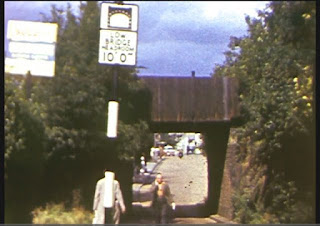Topics for this blog are often prompted by a casual question asked during the course of a conversation or email inquiry. And so it happened that Roger was puzzled that Fleetville had no station along the Hatfield and St Albans Railway which passed through the middle of the eastern districts of St Albans. Good question, but as with many other historical questions the answer is far from straightforward.
We start with a date: 1899. The railway had been here for more than three decades; trains passing through open countryside, using an occupation bridge to pass over a farm track which later became Sutton Road. In 1899 housing and factory development began over a swathe of fields between Castle Road and The Crown. Sutton Road was then on the eastern edge of this development.
Many new residents had asked for the trains to stop in the district, and the most obvious place was at a siding built to deliver coal to the factories in Sutton Road. Station or no station; this was an issue which rumbled on for over three decades,
In 1906 the issue became political – a nasty on-going battle between the Great Northern railway company and St Albans Rural Council (Fleetville did not become a part of the city until 1913). Now that houses were being built and roads laid – though rarely properly surfaced – the Sutton Road bridge became a serious barrier because its very low headroom, though satisfactory for farm carts was quite unsuitable for modern traffic.
 |
| "Sutton Lakes" before WW1. The Lakes remained an irritating feature of the streetscape until the road was levelled and bridge removed. |
An unknown party had been given authority to dig downwards under the bridge to increase headroom, and in so doing reached the water table. Flooding was a serious problem (it is from this period the sobriquet The Sutton Lakes aka the St Albans Lake District was invented). The Rural Council instructed the Company to deal with the drainage problem and to widen the bridge, pave and make the road up on either side and under the bridge. Widening in this case meant from single lane width to full road width. The company stated that in the 1860s it had been required, under the relevant Railway Act, to build and maintain an occupation bridge; after all, at the time it had been farmland.
Every few months from 1906 the Rural Council repeated its instruction, and every few months the council failed to receive a response from the railway company, no doubt aware that these costs would be substantial for a railway which probably never ran at a profit.
By 1910 the company thought that a solution favourable to the company would be to get “the people” on its side. It suggested that if the council would take responsibility for the drainage/flooding issue the company might look favourably on providing a station at Sutton Road in accordance with local wishes, and improve the bridge (it didn’t use the phrase “widen”). By the word station we should probably understand it to be a simple structure with a basic shelter.
 |
| Sutton Road, looking towards Hatfield Road, in 1954. A sign shows a lineside site was being sold and would become a caravan site. |
There was a bit of an auction, with the council offering to pay 60% of the drainage costs; negotiations, such as they had been, stalled again. In June 1910 company officials staged what we might today call a marketing exercise. They boarded a train as far as Hill End, and then walked the track to Sutton Road. Although suggesting this was for surveying purposes, it seems clear that, because it was widely reported, it was intended to keep "the people" on-side and exert pressure on the council.
The impasse continued, nothing happened during the First World War, and there were some half-hearted efforts to pick up the issue in the 20s, including with the Ministry of Health. The company's existing strategy then backfired. It had been confident in selling a significant number of season tickets from Fleetville to London via Hatfield. But that was before WW1 and the subsequent arrival of bus services. By the end of the 20s buses were running “frequently” along Hatfield Road to the Midland (City) Station. The company must have realised that the people living in the homes most likely to be commuting to London lived nearer to the Midland Station and further from the proposed Fleetville Station.
As they say, the business case no longer stacked up! The company never mentioned the station again, but the new City Council kept plugging away, taking the bull by the horns, so to speak, and by c1935 had referred the problem to the Ministry of Transport. We are not to know, of course, the details of discussions or instructions between the company and the MoT, but a notice was finally published by the company asking for tenders to undertake certain works at the site. This came to light in June 1939 ...
… just in time for the Second World War to stop the work dead in its single track, and as we know the post-WW2 period was a whole new world. The locals had wanted a station of course – until something better turned up! Why take the slow train to Hatfield and then a mainline train to the centre of Town, when a short bus hop gave you access to the direct line to St Pancras. So, no station for Fleetville, and by 1951 the company had ceased to carry passengers on the line through Fleetville.

No comments:
Post a Comment